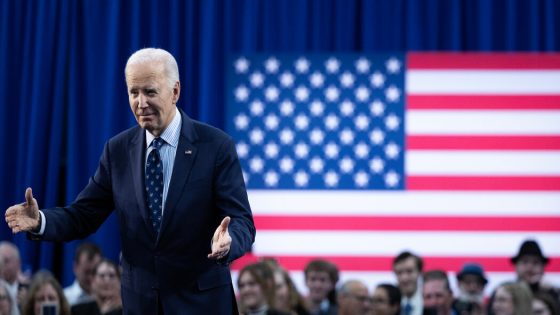Two federal judges in Kansas and Missouri temporarily blocked pieces of the Biden administration’s new student loan repayment plan on Monday in rulings that will have implications for millions of federal borrowers.
Borrowers enrolled in the income-driven repayment plan, known as SAVE, are expected to continue to make payments. But those with undergraduate debt will no longer see their payments cut in half starting on July 1, a huge disappointment for borrowers who may have been counting on that relief.
The separate preliminary injunctions on Monday are tied to lawsuits filed this year by two groups of Republican-led states seeking to upend the SAVE program, a centerpiece of President Biden’s agenda to provide relief to student borrowers. Many of the program’s challengers are the same ones that filed suit against Mr. Biden’s $400 million debt-cancellation plan, which the Supreme Court struck down last June.
“All of this is an absolute mess for borrowers, and it’s pretty shocking that state public officials asked the courts to prevent the Biden administration from offering more affordable loan payments to their residents at time when so many Americans are struggling with high prices,” said Abby Shafroth, co-director of advocacy at the National Consumer Law Center. “It’s a pretty cynical ploy in an election year to stop the current president from being able to lower prices for working and middle-class Americans.”
Eleven states led by Kansas filed a lawsuit challenging the SAVE program in late March in U.S. District Court for the District of Kansas. The next month, Missouri and six other states sued in U.S. District Court for the Eastern District of Missouri. Both suits argued that the administration had again exceeded its authority, and that the repayment plan was a backhanded attempt to wipe debts clean.
The SAVE program, which has enrolled eight million borrowers since it opened in August, isn’t a new idea. It’s based on a roughly 30-year-old design that ties monthly payments to a borrower’s income and household size. But SAVE has more generous terms than previous plans and a heftier price tag. More than four million borrowers qualify for a $0 monthly payment.
The federal judge in Kansas, Daniel D. Crabtree, said earlier this month that only three of the states in the suit there — South Carolina, Texas and Alaska — had the legal standing to move ahead with their challenge, “but just barely.” He said the three had shown that the SAVE program, “more likely than not,” would injure public entities in those states that hold student loans.
The preliminary injunctions freeze parts of the SAVE plan until the case is decided. Judge Crabtree declined to unwind the pieces of the plan already in effect — after all, he wrote, the plaintiffs brought its suit long after the program was in place, “so the court doesn’t see how plaintiffs can complain of irreparable harm from them.”
Likewise, Judge John A. Ross in St. Louis wrote that since tens of thousands of borrowers in Missouri had already applied for forgiveness through the SAVE plan, the court could not readily unwind the process.
“These borrowers and the public have an interest in ensuring consistency in loan repayment programs, and any preliminary injunction would harm their expectations of such consistency,” he wrote.
But Judge Ross sought to strike a balance by ordering a partial injunction, allowing borrowers to continue taking advantage of benefits such as lower monthly payments and limited interest accrual under SAVE, while temporarily blocking the provisions of the plan that would allow borrowers to see their debts forgiven in coming months.
In a written order, he agreed with the Republican states’ attorneys general that the Education Department may have overstepped in allowing a quicker path to loan forgiveness, which critics of SAVE have said would come at significant cost to taxpayers. But, he wrote, the other generous elements of SAVE, such as vastly reduced monthly payments, “still appear to function adequately” even with the loan forgiveness element halted while litigation continues.
The Education Department did not have an immediate comment.
Scott Buchanan, the executive director of the Student Loan Servicing Alliance, an industry group, said the entities that administered federal loans would work under the department’s guidance to carry out the court orders.
“These legal headlines can create a lot of borrower confusion about what it means for them, and once we get timely guidance and resources from the department,” he said, “we’ll be working as best we can to be prepared to answer borrower questions.”
Returning millions of borrowers to repayment last fall, after a 42-month pandemic-related pause, has been challenging. Just as the student loan machinery was coming back online, the Biden administration continued to make a series changes to overhaul the system, while installing fixes to various loan forgiveness programs. So far, the administration has wiped out $167 billion in debt for nearly five million borrowers.
Blocking parts of the SAVE plan, which replaced a plan known as REPAYE, will add stress to a system that already has plenty, borrower advocates said.
“Having two injunctions that are different is chaotic from a legal perspective,” said Persis Yu, deputy executive director of the Student Borrower Protection Center, an advocacy group. “How do you administer a system under all of this chaos?”
Some Republican lawmakers welcomed the temporary rulings. Senator Bill Cassidy of Louisiana said in a statement that the income-driven repayment plan “does not ‘forgive’ debt” but simply transfers the burden onto taxpayers.
Source Agencies


